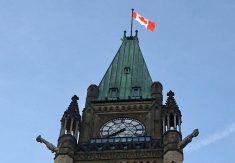B.C. Hydro’s Site C clean energy project has received an environmental assessment certificate from B.C.’s ministers of the environment and forests, lands and natural resource operations.
In a press release issued Oct. 14, environment minister Mary Polak and forests, lands and natural resource operations minister Steve Thomson said, “the project is in the public interest and that the benefits provided by the project outweigh the risks of significant adverse environmental, social and heritage effects.”
The Site C project, located seven kilometres southwest of Fort St. John, would be the third dam in B.C.’s Peace region and would generate enough electricity to power about 450,000 homes per year.
Read Also

African swine fever risk tightens feed ingredient trade rules with Taiwan
Plant-based ingredients bound for Canadian livestock feed will have stricter trade rules if the shipments come from Taiwan, following Canadian Food Inspection Agency changes
The decision to issue the environmental assessement certificate was made following consultation with and input from Aboriginal groups, government agencies, communities and the public.
The province must still decide if it wants to invest in and proceed with the $7.9 billion project.
If the project goes ahead, the environmental assessment certificate comes with 77 legally-binding conditions that B.C. Hydro must meet to be in compliance, including:
* Establish a fund of $20 million to compensate for lost agricultural lands and activities.The funds will be used to support enhancement projects that improve agricultural land, productivity or systems;
* Develop a Wetland Mitigation and Compensation Plan and monitor construction and operation activities that could cause changes in wetland function;
* Develop an Aboriginal Business Participation Strategy to maximize opportunities for Aboriginal businesses;
* Implement on-site health care with physician and nursing services to manage non-urgent issues for the workforce residing in camps;
* Develop protocols for application of construction methods, equipment, material and timing of activities to mitigate adverse effects to wildlife and wildlife habitat;
* Build 50 rental units in Fort St. John, of which 40 will be used for BC Hydro housing and 10 will be available for low-to-moderate income households. Upon completion of the construction phase, the 40 worker housing units will be made available to low-to-moderate income households;
* In collaboration with a Cultural and Heritage Resources Committee that includes Aboriginal groups, develop and implement mitigation measures to manage effects on cultural resources;
*Design the installation and use of a trap-and-haul facility as part of a fish passage management plan;
* Establish three new boat launch/day use sites and provide approximately $200,000 for a Community Recreation Site Fund; and
* Monitor greenhouse gas emissions from the reservoir for the first ten years of operations as part of a Greenhouse Gases Monitoring and Follow-up Program.














